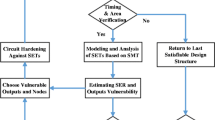Abstract
Single event transients (SETs) on combinational gates are becoming an issue in deep sub-micron technologies, thus efficient and accurate techniques for assessing their impact are strongly required. This paper presents a new technique that embeds time-related information in the topology of the analyzed circuit, allowing evaluating the effects of SETs via zero-delay simulation instead of timed simulation. The analysis of complex designs becomes thus possible at a very limited cost in terms of CPU time. Moreover, circuits enriched with time-related information are suitable for hardware emulation thus allowing further reducing the time for SET-effect analysis, while providing the same accuracy of state-of-the-art approaches based on timed simulations. The paper reports results showing how the proposed method can be effectively used to analyze complex designs.
Similar content being viewed by others
References
L. Anghel and M. Nicolaidis, “Cost Reduction of a Temporary Faults Detecting Technique,” in Proc. IEEE Design, Automation and Test in Europe Conference, 2000, pp. 591–598.
L. Antoni, R. Leveugle, and B. Fehér, “Using Run-Time Recon-figuration for Fault Injection in Hardware Prototypes,” in Proc. IEEE Symp. on Defect and Fault Tolerance in VLSI Systems, 2000, pp. 405–413.
L. Berrojo, I. González, F. Corno, M. Sonza Reorda, G. Squillero, L. Entrena, and C. Lopez, “New Techniques for Speeding-up Fault-Injection Campaigns,” in Proc. IEEE Design, Automation and Test in Europe, 2002, pp. 847–852.
J. Boué, P. Pétillon, and Y. Crouzet, “MEFISTO-L: A VHDL-Based Fault Injection Tool for the Experimental Assessment of Fault Tolerance,” in Proc. IEEE Fault-Tolerant Computing Symposium, 1998, pp. 168–173.
G.S. Choi, R.K. Iyer, and V.A. Carreno, “Simulated Fault Injection: A Methodology to Evaluate Fault Tolerant Microprocessor Architectures,” IEEE Transactions on Reliability, vol. 39, no. 4, pp. 486–491, 1990.
P. Civera, L. Macchiarulo, M. Rebaudengo, M. Sonza Reorda, and M. Violante, “Exploiting Circuit Emulation for Fast Hardness Evaluation,” IEEE Transactions on Nuclear Science, vol. 48, no. 6, pp. 2210–2216, Dec. 2001.
P. Dahlgren and P. Liden, “A Switch-Level Algorithm for Simulation of Transients in Combination Logic,” IEEE Fault Tolerant Computing Symposium, 1995, pp. 207–216.
T.A. Delong, B.W. Johnson, and J.A. Profeta III, “A Fault Injection Technique for VHDL Behavioral-Level Models,” IEEE Design & Test of Computers, Winter 1996, pp. 24–33.
P.E. Dodd and L.W. Messengill, “Basic Mechanisms and Modeling of Single-Event Upset in Digital Microelectronics,” IEEE Tansactions on Nuclear Science, vol. 50, no. 3, pp. 583–602, June 2003.
K.J. Hass and J.W. Gambles, “Single Event Transients in Deep Submicron CMOS,” in Proc. IEEE 42nd Midwest Symposium on Circuits and Systems, 1999, pp. 122–125.
Mei-Chen Hsueh, T.K. Tsai, and R.K. Iyer, “Fault Injection Techniques and Tools,” IEEE Computer, vol. 30, no. 4, pp. 75–82, April 1997.
E. Jenn, J. Arlat, M. Rimen, J. Ohlsson, and J. Karlsson, “Fault Injection into VHDL Models: The MEFISTO Tool,” in Proc. IEEE Fault Tolerant Computing Symposium, 1994, pp. 66–75.
R. Leveugle and K. Hadjiat, “Multi-Level Fault Injection Experiments Based on VHDL Descriptions: A Case Study,” in Proc. IEEE On-line Testing Workshop, 2002, pp. 107–111.
S. Manich and J. Figueras, “Maximizing the Weighted Switching Activity in Combinational CMOS Circuits Under the Variable Delay Model,” in Proc. IEEE European Design and Test Conference, 1997, pp. 597–602.
L.W. Massengill, A.E. Baranski, D.O. Van Nort, J. Meng, and B.L. Bhuva, “Analysis of Single-Event Effects in Combinational Logic-Simulation of the AM2901 Bitslice Processor,” IEEE Transactions on Nuclear Science, vol. 47, no. 6, pp. 2609–2615, Dec. 2000.
T.M. Niermann, C. Wu-Tung, and J.H. Patel, “PROOFS: A Fast, Memory-Efficient Sequential Circuit Fault Simulator,” IEEE Transactions on CAD, vol. 11, no. 2, pp. 198–207, Feb. 1992.
B. Parrotta, M. Rebaudengo, M. Sonza Reorda, and M. Violante, “New Techniques for Accelerating Fault Injection in VHDL descriptions,” in Proc. IEEE Int.l On-Line Testing Workshop, 2000, pp. 61–66.
M. Sonza Reorda and M. Violante, “Fault List Compaction Through Static Timing Analysis for Efficient Fault Injection Experiments,” in Proc. IEEE Symp. on Defect and Fault Tolerance in VLSI Systems, 2002, pp. 263–271.
www.gaisler.com.
www.alphadata.com.
Author information
Authors and Affiliations
Rights and permissions
About this article
Cite this article
Reorda, M.S., Violante, M. A New Approach to the Analysis of Single Event Transients in VLSI Circuits. Journal of Electronic Testing 20, 511–521 (2004). https://doi.org/10.1023/B:JETT.0000042515.67579.c1
Issue Date:
DOI: https://doi.org/10.1023/B:JETT.0000042515.67579.c1




